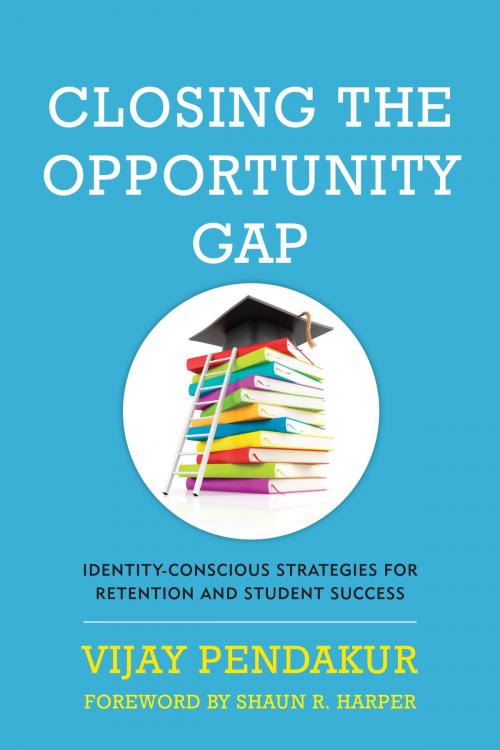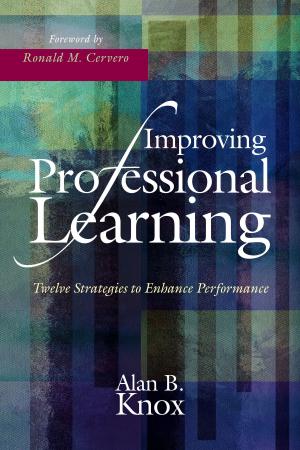Closing the Opportunity Gap
Identity-Conscious Strategies for Retention and Student Success
Nonfiction, Reference & Language, Education & Teaching, Higher Education| Author: | ISBN: | 9781620363140 | |
| Publisher: | Stylus Publishing | Publication: | February 25, 2016 |
| Imprint: | Stylus Publishing | Language: | English |
| Author: | |
| ISBN: | 9781620363140 |
| Publisher: | Stylus Publishing |
| Publication: | February 25, 2016 |
| Imprint: | Stylus Publishing |
| Language: | English |
This book offers a novel and proven approach to the retention and success of underrepresented students. It advocates a strategic approach through which an institution sets clear goals and metrics and integrates the identity support work of cultural / diversity centers with skill building through cohort activities, enabling students to successfully navigate college, graduate on time and transition to the world of work. Underlying the process is an intersectional and identity-conscious, rather than identity-centered, framework that addresses the complexity of students’ assets and needs as they encounter the unfamiliar terrain of college.
In the current landscape of higher education, colleges and universities normally divide their efforts between departments and programs that explicitly work on developing students’ identities and separate departments or programs that work on retaining and graduating higher-risk students. This book contends that the gap between cultural/diversity centers and institutional retention efforts is both a missed opportunity and one that perpetuates the opportunity gap between students of color and low-income students and their peers.
Identity-consciousness, the central framework of this book, differs from an identity-centric approach where the identity itself is the focus of the intervention. For example, a Latino men’s program can be developed as an identity-centered initiative if the outcomes of the program are all tied to a deeper or more complex understanding of one’s Latino-ness and/or masculinity. Alternately, this same program can be an identity-conscious student success program if it is designed from the ground up with the students’ racial and gender identities in mind, but the intended outcomes are tied to student success, such as term-to-term credit completion, yearly persistence, engagement in high-impact practices, or timely graduation.
Following the introductory chapter focused on framing how we understand risk and success in the academy, the remaining chapters present programmatic interventions that have been tested and found effective for students of color, working class college students, and first-generation students. Each chapter opens with a student story to frame the problem, outlines the key research that informs the program, and offers sufficient descriptive information for staff or faculty considering implementing a similar identity-conscious intervention on their campus. The chapters conclude with a discussion of assessment, and suggested “Action Items” as starting points.
In the current landscape of higher education, colleges and universities normally divide their efforts between departments and programs that explicitly work on developing students’ identities and separate departments or programs that work on retaining and graduating higher-risk students. This book contends that the gap between cultural/diversity centers and institutional retention efforts is both a missed opportunity and one that perpetuates the opportunity gap between students of color and low-income students and their peers.
Identity-consciousness, the central framework of this book, differs from an identity-centric approach where the identity itself is the focus of the intervention. For example, a Latino men’s program can be developed as an identity-centered initiative if the outcomes of the program are all tied to a deeper or more complex understanding of one’s Latino-ness and/or masculinity. Alternately, this same program can be an identity-conscious student success program if it is designed from the ground up with the students’ racial and gender identities in mind, but the intended outcomes are tied to student success, such as term-to-term credit completion, yearly persistence, engagement in high-impact practices, or timely graduation.
Following the introductory chapter focused on framing how we understand risk and success in the academy, the remaining chapters present programmatic interventions that have been tested and found effective for students of color, working class college students, and first-generation students. Each chapter opens with a student story to frame the problem, outlines the key research that informs the program, and offers sufficient descriptive information for staff or faculty considering implementing a similar identity-conscious intervention on their campus. The chapters conclude with a discussion of assessment, and suggested “Action Items” as starting points.
This book offers a novel and proven approach to the retention and success of underrepresented students. It advocates a strategic approach through which an institution sets clear goals and metrics and integrates the identity support work of cultural / diversity centers with skill building through cohort activities, enabling students to successfully navigate college, graduate on time and transition to the world of work. Underlying the process is an intersectional and identity-conscious, rather than identity-centered, framework that addresses the complexity of students’ assets and needs as they encounter the unfamiliar terrain of college.
In the current landscape of higher education, colleges and universities normally divide their efforts between departments and programs that explicitly work on developing students’ identities and separate departments or programs that work on retaining and graduating higher-risk students. This book contends that the gap between cultural/diversity centers and institutional retention efforts is both a missed opportunity and one that perpetuates the opportunity gap between students of color and low-income students and their peers.
Identity-consciousness, the central framework of this book, differs from an identity-centric approach where the identity itself is the focus of the intervention. For example, a Latino men’s program can be developed as an identity-centered initiative if the outcomes of the program are all tied to a deeper or more complex understanding of one’s Latino-ness and/or masculinity. Alternately, this same program can be an identity-conscious student success program if it is designed from the ground up with the students’ racial and gender identities in mind, but the intended outcomes are tied to student success, such as term-to-term credit completion, yearly persistence, engagement in high-impact practices, or timely graduation.
Following the introductory chapter focused on framing how we understand risk and success in the academy, the remaining chapters present programmatic interventions that have been tested and found effective for students of color, working class college students, and first-generation students. Each chapter opens with a student story to frame the problem, outlines the key research that informs the program, and offers sufficient descriptive information for staff or faculty considering implementing a similar identity-conscious intervention on their campus. The chapters conclude with a discussion of assessment, and suggested “Action Items” as starting points.
In the current landscape of higher education, colleges and universities normally divide their efforts between departments and programs that explicitly work on developing students’ identities and separate departments or programs that work on retaining and graduating higher-risk students. This book contends that the gap between cultural/diversity centers and institutional retention efforts is both a missed opportunity and one that perpetuates the opportunity gap between students of color and low-income students and their peers.
Identity-consciousness, the central framework of this book, differs from an identity-centric approach where the identity itself is the focus of the intervention. For example, a Latino men’s program can be developed as an identity-centered initiative if the outcomes of the program are all tied to a deeper or more complex understanding of one’s Latino-ness and/or masculinity. Alternately, this same program can be an identity-conscious student success program if it is designed from the ground up with the students’ racial and gender identities in mind, but the intended outcomes are tied to student success, such as term-to-term credit completion, yearly persistence, engagement in high-impact practices, or timely graduation.
Following the introductory chapter focused on framing how we understand risk and success in the academy, the remaining chapters present programmatic interventions that have been tested and found effective for students of color, working class college students, and first-generation students. Each chapter opens with a student story to frame the problem, outlines the key research that informs the program, and offers sufficient descriptive information for staff or faculty considering implementing a similar identity-conscious intervention on their campus. The chapters conclude with a discussion of assessment, and suggested “Action Items” as starting points.















